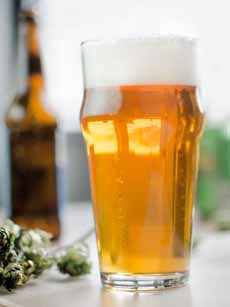FOOD HOLIDAY: National IPA Day
|
[4] American craft brewers are known for their creative—some say cheeky—names for their beers. Here’s an IPA from California’s Stone Brewing Co. |
August 1st is National IPA Day, a celebration of India Pale Ale (photo #1), America’s fastest-growing category of craft beer. It’s so hot that Spielgau has developed a special IPA glass (photo #2) to best show off its flavors and aromas. India Pale Ale is a highly-hopped beer style within the broader category of pale ale, a category that originally referred to an ale that had been brewed with pale malt. India Pale Ale is not a beer created in India; but was created in England for Brits living in India. Here’s the scoop. The history of IPA, a 19th-century creation, begins in ancient times. Beer has been brewed since before written history. Archaeologists date it to around the 6th millennium B.C.E. The oldest known recipe found to date is one for brewing beer, found on stone tablets in Sumer, in southern Mesopotamia. The “fertile crescent” or “cradle of civilization” between the Tigris and Euphrates Rivers was the original area for much cultivation of hitherto wild foods, and much food innovation. Today, the area includes modern Iraq, northeastern Syria, southeastern Turkey, and southwestern Iran. By 4000 B.C.E., the Babylonians were brewing at least sixteen varieties of beer (when you see all of the different styles in this glossary, you won’t be surprised at that number). The Pharaohs of Egypt paid their workers with jugs of beer (later, the Romans would pay their legions in salt, leaving us with the phrase, “worth his salt” rather than “worth his beer”) (source). Beer is the third most-frequently-consumed beverage in the world, after water and tea. For those of you who have never been exactly clear on the difference between all the beer types—ale, pale ale, bock, pilsner, and lager (only that you’re happy to drink them all)—check out our Beer Glossary, a tutorial in the types of beer. The pale ales of the early 18th century were lightly hopped, but by the mid-18th century they evolved; most were manufactured with coke-fired malt, which produced an even paler ale via less smoking and roasting of barley in the malting process. In the 19th century, the British living in the Indian Empire drank ale from England, largely because the Indian water supply had microbes that caused digestive problems to humans not raised on it. But not all beer could hold up on the long journey in a hot ship’s hold. IPA had the level of alcohol (7%-8%) and hops (which act as a preservative) to withstand the voyage of up to six months. (Today, of course, transportation problems have been solved and there’s plenty of bottled water for travelers in foreign lands.) Demand for a pale ale that could withstand the voyage and the heat en route to India became known as India Pale Ale. Developed in England around 1840 for the export market, it later became a popular brew at home. Originally a very highly alcoholic beer to preserve it at sea, the IPA style has evolved (or devolved, in the case of British IPAs) to 5.5% ABV†), but are still highly hopped. Double IPAs, also called Imperial IPAs, are a stronger, very hoppy and high-alcohol IPA style; the beers typically have alcohol content above 7.5% A.B.V. While trending now, IPAs have long been brewed in the U.S. American IPAs are characterized by their hops, with a floral, fruity, citrus-like, piney or resinous American-variety hop character. The American IPAs are all about hop flavor, hop aroma and hop bitterness. Instead of floral and spicy European hops, American hops, grown in the Pacific Northwest, provide distinctively different flavor notes, such as: In addition to Europe, Australia, New Zealand and other areas grow still more species of hops. Here’s more about them. |
|
|
AMERICAN IPA STYLES Within a category even as narrow as American IPA, different styles can be achieved by using different brewing techniques, particular strains of yeast, varieties of hops, the timing of adding the hops, and adjusting the chemistry of the water, and more. Among American IPA brewers, three main styles have evolved. Although the style has become popular in the region, it need not be brewed in that region. Nor must any brewer in a particular region subscribe to a particular style. This new style introduces lactose‡ into the brewing process, often with the addition of a fruit and a vanilla bean. It has a lighter appearance and a thicker body—hazy like New England IPAs. The biggest difference between the two is the addition of lactose. Why not celebrate National IPA Day—the first Thursday in August—with one of each of these IPAs, plus an English IPA to honor where they all began. ________________ *For hop enthusiasts: American hops include, among others, Amarillo, Cascade, Centennial, Chinook, Citra, Columbus, Neomexicanus, Nugget, Simcoe, Tomahawk, Warrior. New varieties are always under development. †A.B.V. is Alcohol By Volume, the percentage of alcohol in a product—beer, liqueur, spirits, etc. You double the A.B.V. to get the proof. For example, a 5% A.B.V. beer is 10 proof. ‡Lactose is a non-fermentable sugar derived from milk, that adds sweetness and body to beer. It has traditionally been used as an ingredient in English-style sweet stouts, commonly referred to as milk stouts. |
||






